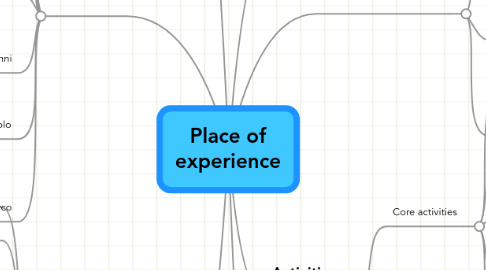
1. Project outcomes
1.1. Feasibility study
1.1.1. Market research
1.1.1.1. Potential customers
1.1.1.2. Potential companies
1.1.2. Business model
1.1.3. Business plan
1.2. List of financial sources
1.2.1. Municipality
1.2.2. Local banks
1.2.3. Founders (Maffei, etc...)
1.3. Architectural/space concept
1.3.1. Potentially a physical model
1.3.1.1. To show a physical demo and prove we have worked!
1.3.2. 3D video done with Autocad + Blender
1.4. Prototype: imagine a real setup
1.4.1. biella
1.4.2. milano
1.4.3. torino
1.5. Definition of activities
1.6. Final Report
1.6.1. old case studies
1.6.2. reports
1.6.3. new case studies
1.7. Final presentation
1.7.1. List all the work we have done
1.7.2. Talk to the stakeholders!
1.7.3. Show feasibility
2. Case studies
2.1. Eataly (proposed by Cantamessa)
2.2. Stoll: is it more "open" than Shima?
2.3. Wholefoods ( Local Producer Loan Program )
2.4. Fondazione Pistoletto
2.4.1. Claudia
2.4.2. Federica Ricci
2.4.3. Nova civitas
2.5. Incubators (MI/TO)
2.6. The Hub
2.7. Borsa Sociale
2.8. Fabbrica del vapore (Milano)
2.8.1. Atelier Maschere Nere: Riccardo Trovati, 347 5090325
2.8.2. architetto Claudio Grillone
2.8.3. Project4
2.9. Grameen
2.10. Oxfam
2.11. Kiva
2.12. Salvation army
2.13. CentoCanti (eventi e mostre itineranti a Milano)
2.13.1. Matteo Martelli, 349 5481901 http://www.centocanti.it/
2.14. Nuove Onde
2.14.1. Giulia Pavan 335 300888
2.15. Docks Dora
2.16. ToolBox Torino
2.17. Zegna
3. TODOs
3.1. New report index
3.2. Rent of Shima machineries: is it possible?
3.3. What is the max production in a day?
3.4. Shima programmer: part-time or on-demand
3.5. Domenico
3.5.1. Market analysis
3.5.1.1. First draft by 15th June
3.5.2. Business plan
3.6. Kate
3.6.1. Marketing
3.6.2. Business plan
3.7. Giovanni
3.7.1. Concept space and drawings
3.7.1.1. First draft by 20th June
3.7.2. Contact toolbox
3.7.3. Cost of space
3.8. Paolo
3.8.1. 3D model
3.8.1.1. by September
3.9. Marco
3.9.1. 3D model and writing
3.9.2. Cantamessa
3.9.3. Camera di commercio
3.9.4. Bilancio Colette (?)
4. Business model
4.1. Revenues
4.1.1. Mainly from fashion-related services
4.1.2. Shima machinery rent
4.1.3. Sale of clothes
4.2. Financial sources
4.2.1. From our own
4.2.2. Municipalities and public entities
4.2.3. From Team C's work ("Eataly model" proposed by Cantamessa)
4.2.4. Local banks
4.3. Cooperativa
4.3.1. http://www.legacooplombardia.it/diventarecoop.pdf
4.3.2. http://www.retecivica.trieste.it/informagiovani/default.asp?tabella_padre=sx&id_sx=55&ids=5&pagina=-&tipo=blocchi_sx_55
5. Activities
5.1. Core activities
5.1.1. Clothes selling
5.1.1.1. Will the store be open always?
5.1.2. Fashion contests for designers / Talent scouting
5.1.2.1. Be incubator for those talents
5.1.2.1.1. Just like The Hub
5.1.2.1.2. Rent to them not just the machineries but also the space, etc
5.1.3. Rent of machine hours
5.1.4. Fashion Classes
5.1.4.1. No elderly
5.1.4.2. Connection with universities
5.1.4.2.1. Eataly
5.1.4.2.2. UniIdee
5.1.5. Fashion shows and guided tours (processi in vista)
5.2. Fashion-related activities
5.2.1. Fashion photography
5.2.2. Theatrical shows (we provide the clothing)
5.2.3. Food/wine tasting (our clothes are exposed in the same room)
6. ASP midterm review: The non‐profit and “cultural producer” model is risky if developed as an alternative to the “for profit” model envisioned by the other two teams. Should consider seeing it as a complement. In any case, it is important to detail the feasibility study at a sufficient degree.
7. Store
7.1. One four-season Shima machinery
7.1.1. http://www.shimaseiki.com/product/knit/sig/
7.1.2. It is not Wholegarment!
7.1.3. http://www.shimaseiki.com/product/knit/newsesswg/index3.html
7.1.4. IT is a WholeGarment machine but I'm not sure it is "multifinezza"
